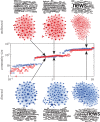Interest communities and flow roles in directed networks: the Twitter network of the UK riots
- PMID: 25297320
- PMCID: PMC4223916
- DOI: 10.1098/rsif.2014.0940
Interest communities and flow roles in directed networks: the Twitter network of the UK riots
Abstract
Directionality is a crucial ingredient in many complex networks in which information, energy or influence are transmitted. In such directed networks, analysing flows (and not only the strength of connections) is crucial to reveal important features of the network that might go undetected if the orientation of connections is ignored. We showcase here a flow-based approach for community detection through the study of the network of the most influential Twitter users during the 2011 riots in England. Firstly, we use directed Markov Stability to extract descriptions of the network at different levels of coarseness in terms of interest communities, i.e. groups of nodes within which flows of information are contained and reinforced. Such interest communities reveal user groupings according to location, profession, employer and topic. The study of flows also allows us to generate an interest distance, which affords a personalized view of the attention in the network as viewed from the vantage point of any given user. Secondly, we analyse the profiles of incoming and outgoing long-range flows with a combined approach of role-based similarity and the novel relaxed minimum spanning tree algorithm to reveal that the users in the network can be classified into five roles. These flow roles go beyond the standard leader/follower dichotomy and differ from classifications based on regular/structural equivalence. We then show that the interest communities fall into distinct informational organigrams characterized by a different mix of user roles reflecting the quality of dialogue within them. Our generic framework can be used to provide insight into how flows are generated, distributed, preserved and consumed in directed networks.
Keywords: Twitter; UK riots; community detection; directed networks; flow roles; graph theory and stochastic processes.
Figures






References
Publication types
MeSH terms
LinkOut - more resources
Full Text Sources
Other Literature Sources

